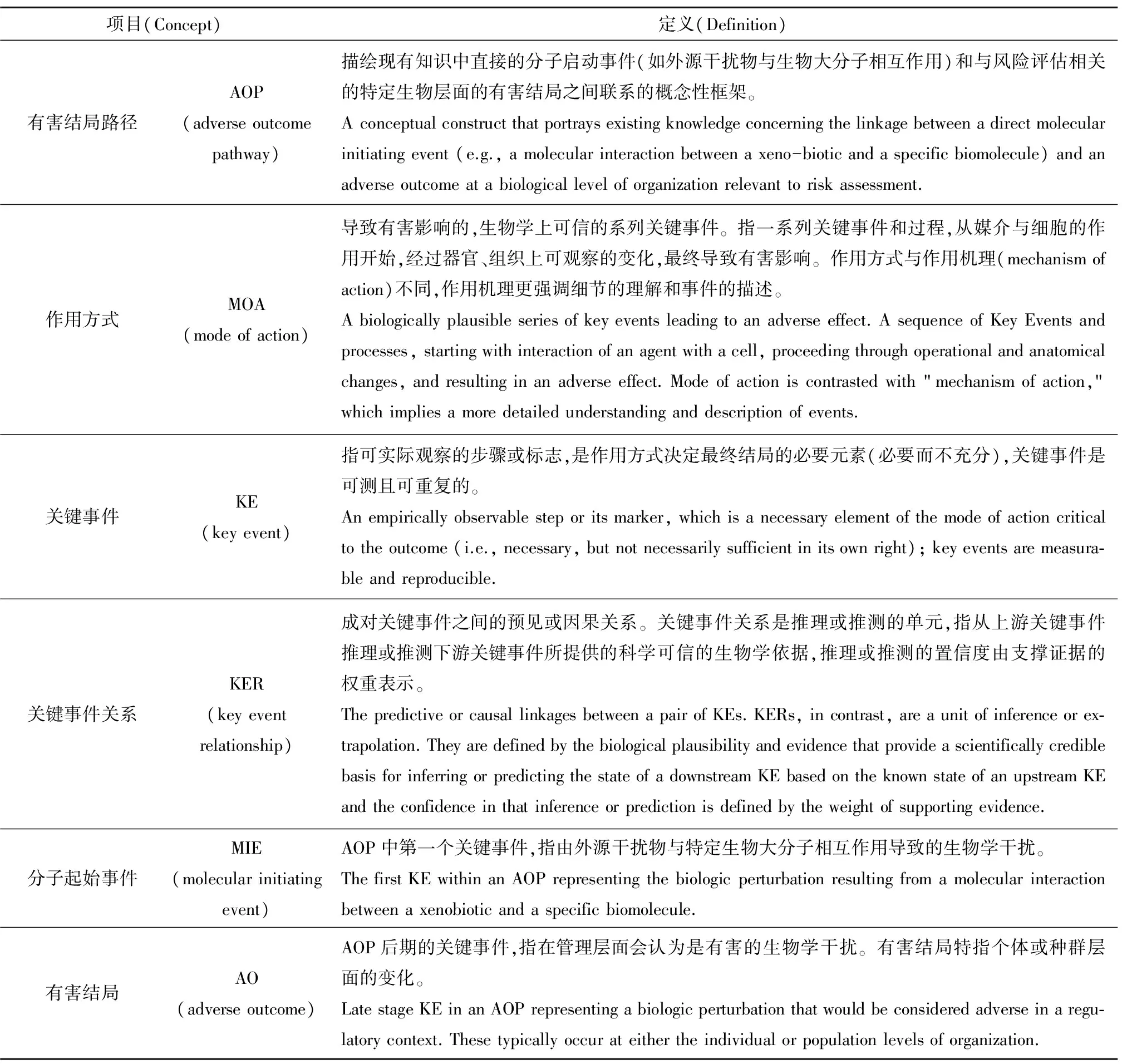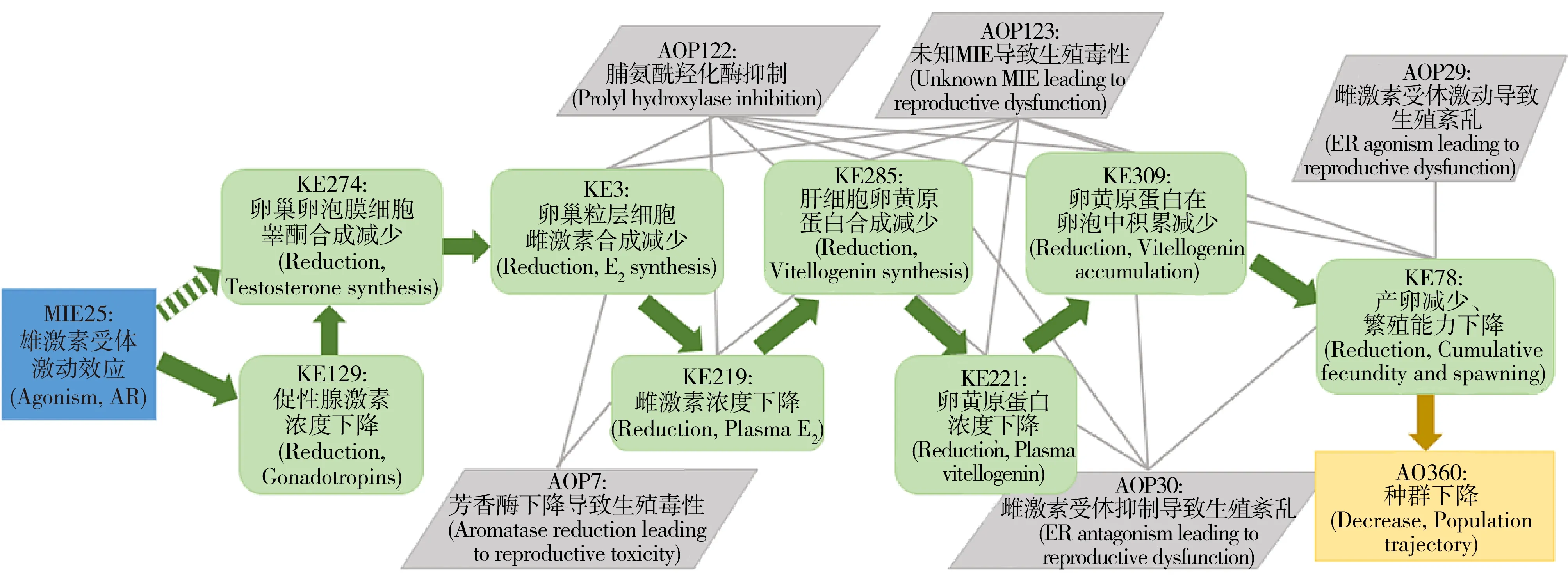計算毒理學在內分泌干擾物篩選上的應用和展望
陳欽暢,譚皓月,史薇,于紅霞
污染控制與資源化研究國家重點實驗室,南京大學環境學院,南京210023
計算毒理學在內分泌干擾物篩選上的應用和展望
陳欽暢,譚皓月,史薇,于紅霞*
污染控制與資源化研究國家重點實驗室,南京大學環境學院,南京210023
內分泌干擾物通過干擾內分泌系統導致多種疾病,如生殖疾病、肥胖癥甚至癌癥。然而,面對環境中大量潛在的內分泌干擾物,傳統的體外、體內評估方法由于成本高、耗時長等問題,難以實現內分泌干擾物的高通量篩查。計算毒理學逐漸發展成為被美國環保局(Environmental Protection Agency, EPA)、經濟合作與發展組織(Organization for Economic Co-operation and Development, OECD)等機構所推薦的內分泌干擾物篩選與預測方法。本文綜述了計算毒理學在內分泌干擾物篩選上的進展,主要包括分子對接和分子動力學模擬的應用,并對有害結局路徑(adverse outcome pathway, AOP)的方法進行介紹和展望。
計算毒理學;內分泌干擾;分子對接;分子動力學模擬;AOP
Received6 February 2017accepted13 March 2017
Abstract: Endocrine disrupting chemicals (EDCs) cause a variety of diseases, such as reproductive diseases, obesity and even cancer, by interfering with the endocrine system. However, in the face of a large number of potential endocrine disruptors in the environment, traditional in vitro and in vivo assays are difficult to achieve high throughput screening of endocrine disruptors due to their high cost and time consuming. Computational toxicology has been recommended as the screening and predicting method by the US Environmental Protection Agency (EPA), the Organization for Economic Co-operation and Development (OECD) and so on. Here, we discuss the application of computational toxicology methods, particularly molecular docking, molecular dynamics simulations and the developing adverse outcome pathway (AOP), in guiding the screening of EDCs.Keywords: computational toxicology; endocrine disrupting; molecular docking; molecular dynamics; AOP
1 前言(Introduction)
1.1 內分泌干擾效應與內分泌干擾物
內分泌系統指由一系列腺體分泌激素進入內循環系統運輸并直接作用于目標器官的系統。內分泌系統的信號由激素傳遞,激素有不同的化學結構,主要包括3種:類花生酸類(eicosanoids)、甾體類(steroids)和氨基酸衍生物(胺類、肽鏈和蛋白質)。激素通過與目標細胞的特定受體蛋白結合,激活信號轉導通路,達到調節細胞功能的作用,調節著生物體幾乎所有生物學過程。已有報道表明,一些化學物質如雙酚A(bisphenol A, BPA)、多環芳烴(polycyclic aromatic hydrocarbons, PAHs)及一系列殺蟲劑等的暴露會干擾內分泌系統并產生有害影響,這類物質被稱為內分泌干擾物(endocrine disrupting chemicals, EDCs)。內分泌干擾物的暴露會增加生殖疾病、心肺疾病、免疫系統疾病和神經系統疾病的風險,甚至導致腫瘤和癌癥的發生[1]。據Attina等[2]的模型估計,2010年歐盟國家內分泌干擾物導致的疾病花費占國內生產總值(GDP)的1.28%,為2 170億美元,而美國的達到3 400億美元,占GDP的2.33%,內分泌干擾物篩選的研究迫在眉睫。
1.2 內分泌干擾物的實驗檢測手段
檢測內分泌干擾物的實驗手段包括體外(in vitro)和體內(in vivo)實驗。體外實驗包括細胞增殖實驗(cell proliferation assays)[3]、報告基因實驗(reporter gene assays)[4]、酵母雙雜交實驗(yeast two-hybrid assays)[5]、結合實驗(binding assays)[6]等。體內實驗多采用哺乳動物[7-8]、鳥類[9-10]、魚類[11-12]、兩棲類[13-14]等動物。過去十幾年來,體外實驗被合理開發應用到各種高通量測試篩選方法中,以應對數量巨大的潛在危害化合物,以及動物體內測試的巨大開銷和倫理問題[15]。由美國環保局(Environmental Protection Agency, EPA)、國立衛生研究院(National Institutes of Health, NIH)和食品與藥品管理局(Food and Drug Administration, FDA)等跨部門合作的21世紀毒理學(Tox21)項目,采用高通量篩選技術測試約10 000種環境化合物和藥物的毒性,其中內分泌干擾是重要方面,關于雌激素干擾效應及信號通路的研究結果已于2014年發布[16]。
現階段評估一個化合物的內分泌干擾作用往往需要體內和體外實驗的結合。美國EPA內分泌干擾物篩選項目(Endocrine Disruptor Screening Program, EDSP)于2012年開展了EDSP21項目,采用2個級別的篩選測試手段(Tier 1和Tier 2)評價化合物的內分泌干擾活性。其中級別1測試包括5種體外實驗和5種體內實驗,級別2則是更深層次或多代體內測試。經過級別1測試具有干擾活性的化合物進入級別2測試,評估其內分泌干擾效應。目前,超過1 800種化合物內分泌相關活性的高通量篩選數據(主要為包括雌激素受體ER、雄激素受體AR結合和轉錄激活的級別1體外篩查數據)已可在EDSP21 Dashboard網站(http://actor.epa.gov/edsp21/)獲取。
1.3 內分泌干擾物的模擬預測手段
體外和體內實驗手段雖然能完整評價化合物的內分泌干擾效應,但是其成本高、耗時長,難以對全球現有超過126 000 000種化合物參考(http://www.cas.org)進行逐一篩選。因此,亟需發展化學品內分泌干擾效應篩選的計算毒理學(computational toxicology)方法[17]。計算毒理學方法指通過綜合體內、體外實驗和計算機模擬等不同來源的數據,開發數學或計算機模型,以更好理解或預測化合物干擾效應的方法[18]。近年來,計算毒理學得到越來越多的關注,美國EPA于2005年成立了國家計算毒理學中心(National Center for Computational Toxicology, NCCT),致力于開發新的評估化合物安全性的方法,即計算毒理方法;經濟合作與發展組織(Organization for Economic Co-operation and Development, OECD)于2008年開發的計算毒理軟件OECD QSAR Toolbox如今也進入3.4版本,并得到各國政府、化學工業的接受和使用。
定量結構-效應關系(quantitative structure-activity relationship, QSAR)是最早開發和發展的計算毒理學方法,將代表化合物結構、物理、化學性質的分子描述符(molecular descriptors)與特定效應終點或有害結局(adverse outcome, AO)建立聯系,達到預測目的,在不同尺度的內分泌干擾效應,如核受體結合[19-20]、轉錄激活[21-22]、器官和個體有害結局[23-24]等,都得到廣泛運用。我國陳景文教授、張愛茜教授、高士祥教授、王連生教授和于紅霞教授等的團隊在內分泌干擾物的QSAR研究上都做了大量工作[25-29],比如Li等[25]計算了517種有機化合物的705個分子描述符,并選取其中的13個分子描述符建立雌激素效應的QSAR模型,發現有機分子的雌激素活性主要與分子尺寸、形狀特征、電負性和范德華體積等相關。如今,QSAR已經發展成較為成熟的計算毒理學方法,得到OECD等組織的認可,基于QSAR開發的毒性預測軟件,如TEST、ECOSAR、OncoLogic等,也得到廣泛應用。然而,QSAR往往忽略干擾物的效應機制,采用的分子描述符往往也沒有直接或明確的藥理學或生物學意義[30]。
激素分子與體內調節相關生理功能的大分子,如受體蛋白等之間的相互關系在內分泌系統信號傳遞中具有重要作用。因此對干擾物與受體作用關系的研究是內分泌干擾物篩選的重要研究手段,很多體外實驗都是以干擾物與受體作用關系為對象研究化合物的內分泌干擾效應的[31-32],而分子對接(molecular docking)和分子動力學(molecular dynamics, MD)模擬方法作為基于干擾物與受體作用關系的計算毒理學研究方法也得到越來越多的應用。在此基礎上,為了更加深入地理解內分泌干擾效應作用機制,OECD、美國EPA等組織開展了開發有害結局路徑(adverse outcome pathway, AOP)的項目,將極大促進基于效應機制的計算毒理學的發展。因此,本文將對分子對接、MD模擬和AOP等基于效應機制的計算毒理學方法在內分泌干擾物篩選上的應用進行綜述。
2 分子對接及其應用(Molecular docking and its applications)
分子對接是預測配體與受體結合成穩定復合體時配體所處的最佳位置和方向的方法[33]。內分泌系統中主要的受體蛋白(圖1)是包括雌激素受體(estrogen receptor, ER)、雄激素受體(androgen receptor, AR)、甲狀腺激素受體(thyroid hormone receptor, TR)、糖皮質激素受體(glucocorticoid receptor, GR)等在內的核受體(nuclear receptor, NR),它們都受激素調節并控制大量基因的表達[34]。隨著晶體學和生物化學技術的發展,越來越多核受體的晶體結構被解析出來(圖1)[35-39],這些晶體結構都可以通過Protein Data Bank網站(http://www.rcsb.org/pdb/home/home.do)獲得,使采用對接和MD模擬等方法篩選內分泌干擾物成為可能[40]。但已有的多為人類的受體,對于其他物種,往往需要通過同源建模(homology modeling)構建受體結構[41]。
分子對接的使用有助于加深對配體受體相互作用機制的理解。Nose等[42]用對接的方法從14個酚類物質中篩選出4-(1-adamantyl)phenol為擬雌激素物質,經驗證確實具有很強的雌激素活性。對對接結果的分析發現,與雌激素類似,4-(1-adamantyl)phenol的羥基也能與ERα中Glu353和Arg394氨基酸形成氫鍵。D'Ursi等[43]采用柔性對接的方法探索了內分泌干擾物與ER、孕酮受體(progesterone receptor, PR)和AR的相互作用,發現這些內分泌干擾物與受體的相互作用主要取決于化合物與配體結合腔(ligand binding cavity, LBC)中多個氨基酸殘基之間的疏水性作用,對于親脂性內分泌干擾物,它們有能力適應甾體受體的疏水性LBC,并呈現非特異性結合模式。

圖1 部分已解析的核受體結構[35-39]Fig. 1 Some of the structures of nuclear receptors (NRs) that have been refined[35-39]
由于內分泌干擾物往往能同時作用于不同受體,研究干擾物與不同受體的相互作用能預測潛在的效應終點。Yuriev等[45]針對人體14種NR,選取了18個完整、可靠的晶體結構建立對接模型,通過對接得到化合物與各個NR的結合能,判斷對哪些受體更敏感,從而判斷化合物潛在的內分泌干擾效應[44],這種方法被稱為反向對接法。于紅霞教授團隊最近也采用反向對接開發了一個針對39個人類NR的程序SPEN,該程序經過10種化合物的驗證具有良好的表現[46]。
分子對接可以與QSAR結合,構建多維QSAR模型。Vedani等[47]采用柔性對接和QSAR結合的方法建立了預測ER結合能力的6維QSAR模型,并用于對106種內分泌干擾物的篩選,結果r2達到0.885,表明具有很好的篩選能力。Vedani團隊將這種方法拓展到AR、TR、GR等11個核受體,并建立了基于網站的預測平臺VirtualToxLab[48]。分子對接在藥物開發領域也產生了一些新方法,如基于分子碎片的對接技術正在快速發展,雖然在內分泌干擾物篩選上還沒有得到應用,但是不失為提高對接結果精確度的選擇[49]。然而分子對接在很大程度上仍受受體柔性的制約,而對受體賦予過多的柔性會導致對計算的要求呈指數增加并且變得不切實際[50]。
在實際應用中分子對接受受體結構和配體種類的影響較大,針對相同種類、數量較少的化合物時,分子對接能得到較好的預測效果,對接的結合能可以很好預測化合物與受體的結合效力[51];而針對大量具有不同結構的化合物時,預測效果一般,甚至比普通的QSAR模型差[52]。因此,選擇合適、可靠的受體模型是分子對接模型構建的重點。針對不同種類的化合物提供不同對接模型是可行的解決方法;也可以借助分子動力學模擬,產生多個受體模型進行對接[53]。
3 分子動力學模擬及其應用(Molecular dynamics simulations and the applications)
隨著計算機技術的發展和計算能力的提升,分子動力學模擬逐漸成為研究生物大分子作用的標準方法[54]。分子動力學模擬是研究原子和分子物理運動的計算機模擬方法,所有分子和原子在給定的時間范圍內相互作用,形成一個動態變化的系統,以此研究生物分子之間的相互作用[55]。
MD模擬有助于探索干擾物作用下受體蛋白及配體本身的構象變化。Li等[56]用MD模擬研究了內分泌干擾物的雌激素干擾效應,發現干擾物與ER在2 ns的模擬下都能達到穩定狀態,并且干擾效力更強的化合物能與ER的His524氨基酸穩定形成氫鍵。采用MD模擬還能發現蛋白質的關鍵結構及活性產生的關鍵變化[57]。Wang等[58]通過對AR骨架變構情況的比較發現12號螺旋(Helix 12, H12)在MD模擬過程中具有最顯著的位置變化,認為H12的位置變化是抗雄激素活性產生的關鍵。Wang等[58]還發現H12在10 ns模擬時間內達到平衡是抗雄性活性產生的重要特征,且穩定時間與活性強弱呈負相關。
干擾物與受體蛋白LBC的結合情況仍然是MD研究的重點。Martínez等[59]通過MD模擬發現了配體逃離TR-LBC的3種可能途徑。有學者進一步用操縱分子動力學(steered molecular dynamics, SMD)模擬探究配體從各逃離途徑逃離配體結合腔的難易程度[60-62]。Martínez等[61]發現配體逃離TR的最佳途徑是位于H1、H2和H3處的通道3,而且當配體親水部分能與受體外部的水分子接觸時逃離過程會變得更輕松。另一方面,有研究表明,干擾物的誘導能使受體H12的位置發生變化,而其穩定位置正好擋住配體,使配體無法從LBC中逃離,受體形成的這種結構稱為“老鼠夾(mousetrap)”結構[56, 63]。
熱力學計算也是MD模擬的常用分析方法。采用MM/PBSA或MM/GBSA(molecular mechanics with Poisson-Boltzmann or generalized Born and surface area)方法計算配體-受體結合自由能ΔGbinding可用于預測配體與受體間的結合效力。van Lipzig等[64]將計算得到的雌激素干擾物與ER的結合自由能和實驗測得的結合效力比較,發現兩者的相關系數達到0.94。結合自由能還能區分干擾物對受體不同亞型的選擇性[65-66]。Martínez等[65]分別計算了配體Triac與TRα和TRβ相互作用的結合自由能,發現Triac與TRα的結合自由能顯著低于TRβ,導致其對TRα具有高度選擇性。
除了干擾物與核受體的結合,核受體與其他蛋白質的相互作用,如與共調節因子作用、二聚現象等[67-69],也是影響內分泌干擾效應產生的重要過程。研究表明ER的二聚作用大大抑制了E2逃離LBC[69]。于紅霞教授團隊[67]最近的MD研究也表明,共調節因子在化合物甲狀腺激素干擾活性產生過程具有重要作用,抗甲狀腺激素干擾物與TR結合能促進共抑制因子而不是共激活因子與TR結合,從而導致抗性的產生。因此,考慮蛋白質受體與其他調劑因子的作用過程,對生物大分子間作用,如共調節因子結合、二聚作用和與DNA的結合等進行模擬,是MD模擬在內分泌干擾物篩選上的重要發展方向。另外,在MD模擬中采用量子力學/分子力學(QM/MM)耦合的方法,將配體部分用QM計算,其他部分用MM模擬的方法,有助于提高模擬的精確度,并有利于更深入探索配體受體之間的相互作用。陳景文教授團隊[70]采用QM/MM的方法,探索了電中性和陰離子形態下酚類內分泌干擾物與甲狀腺素運載蛋白(transthyretin, TTR)的結合,發現陰離子形態比電中性的酚類物質與TTR結合更強,認為離子形態的考慮是內分泌干擾物虛擬篩選過程不可忽視的機制。
4 AOP的發展和展望(Development and prospect of AOP)
隨著對效應機制理解的不斷深化,AOP概念逐漸發展起來。AOP就是描繪從分子啟動事件(MIE)的開始,由一系列關鍵事件(KE)和之間關系(KER)連接,到有害結局(AO)之間關系的框架[71],與AOP相關的各種概念如表1所示。內分泌干擾效應的產生不只是干擾物與靶標相互作用,還包括生物大分子間、細胞層次、器官層次的變化(如圖2),因此,對AOP的研究有助于獲得更加精確和透徹的預測效果。然而這種預測方法是建立在對干擾效應作用通路足夠明晰的基礎上,這也是目前面臨的最大挑戰[72]。隨著有害結局路徑知識庫(Adverse Outcome Pathway Knowledge Base, AOP-KB: http://aopkb.org/)的建立,越來越多AOP被開發并在AOP-KB平臺上共享,這將大大促進AOP在計算毒理學預測上的應用。

表1 與有害結局路徑(AOP)相關概念的定義[71]Table 1 Definition of concepts relevant to adverse outcome pathway (AOP)[71]

圖3 雄激素受體激動效應導致生殖紊亂的AOP[73]Fig. 3 AOP: Androgen receptor agonism leading to reproductive dysfunction[73]
目前已有的AOP為20個,其中包括與雌激素、雄激素、甲狀腺激素受體等相關的5個內分泌干擾AOP。Villeneuve[73]開發并發表了有關雄激素受體激動效應導致生殖功能紊亂的AOP(AOP23,如圖3所示),干擾物激活雄激素受體(MIE),導致睪酮、雌激素合成下降,血液雌激素濃度降低,進而肝臟卵黃原蛋白合成下降,血液中卵黃原蛋白濃度降低,卵母細胞吸收量減少,進而使產卵下降,最終導致生殖功能紊亂的AO產生。Villeneuve等[74]還總結了AOP開發的五大原則:(1)AOP不具有化合物特異性;(2)AOP是模塊化的,且構成要素可重復利用;(3)每個獨立的AOP都由單一系列的KE和KER構成;(4)由具有相同KE和KER的AOP構成的網絡(圖2)是預測真實世界情況的基礎單元;(5)AOP是可以隨著新認識的形成而不斷演化的。這些原則的考慮有助于對AOP的理解和應用。
MIE和KE都是AOP必不可少的組成部分。由于MIE直接與干擾物相互作用,由此開始整條通路的調節,并最終到達AO終點,干擾物的結構和性質與MIE之間的聯系比其他任一節點和效應終點都強[75]。因此,正如QSAR和分子模擬所做的,大多數計算機預測模型都以MIE為研究對象。然而,MIE與AO并不是直接的相互關系,它們之間至少存在一個KE,并且不同的MIE都有可能導致相同的AO產生,形成AOP網絡(圖2)[76]。以前面Villeneuve[73]開發的雄激素受體激動效應導致生殖功能紊亂的AOP為例,血液雌激素濃度降低同時會與芳香酶活性降低導致生殖毒性的AOP(AOP7)產生交聯,通過另一條AOP造成生殖問題,多條通路的交聯從而形成AOP網絡(圖3)。干擾物與最終AO之間的網絡關系,使針對單一靶標受體的預測方法具有更大的不確定性。
將MIE、KE、AO之間用一系列的數學模型聯系起來[77],可建立定量AOP(qAOP)模型。學者們相信,通過建立qAOP可以將體外實驗得到的數據,如配體受體結合效力,作為qAOP的輸入信息,通過系列數學模型的模擬計算預測潛在的內分泌干擾活性,甚至模擬劑量-效應關系和時間進程行為[71]。AOP-KB平臺上推出了Effectopedia模塊,通過量化KE之間的關系,建立qAOP。目前,Effectopedia模塊還處于發展階段,但Beta版本的軟件已發布(http://www.effectopedia.org/)。此外,還有其他系統生物學計算模擬軟件,如PK-Sim和MoBi都具有很好的qAOP模型構建和模擬功能[78]。然而,qAOP需建立于明確的作用機制之下,目前還處于發展階段,其定量預測能力還有待實驗驗證。
既然可以利用體外實驗的數據,通過AOP預測最終的干擾效應,那么計算預測方法與AOP的結合也將成為可能。事實上,AOP概念正是來源于利用QSAR、生物標記物(biomarker)和其他機制數據提高對毒理學的認識和預測化學品暴露的潛在有害影響的想法[64]。由于對接和MD模擬的靶標往往與AOP中的MIE或KE相對應,分子模擬與AOP結合進行模擬預測將成為AOP發展中的重要研究方向。然而,限于目前AOP仍處于起步階段,還沒有較為成功的AOP與模擬預測方法結合的案例。
5 總結和展望(Conclusions and prospect)
內分泌干擾物是導致多種疾病,如生殖疾病、肥胖癥和與激素相關的癌癥等的重要誘因,眾多化合物都具有潛在的內分泌干擾效應,使內分泌干擾問題在化合物風險評估上顯得尤為突出。然而,評估一個化合物的內分泌干擾效應需要耗費大量的成本,無法對成千上萬種化學品進行逐一測試。計算毒理學大大簡化了這一過程,其使用也逐漸受到認可。本文基于內分泌干擾的效應機制,介紹了分子對接、MD模擬和AOP這3種計算毒理學方法及其在內分泌干擾物篩選上的應用。
分子對接與QSAR相比更有助于效應機制的理解,通過反向對接能預測化合物可能的內分泌干擾活性終點,還能與QSAR結合構建多維QSAR模型。MD模擬有助于探索配體-受體相互作用關系及兩者的變化,探索重要的結構變化,并借助熱力學計算預測結合效力。AOP將MIE與最終AO用一系列KE和KER連接,形成完整的、明晰的通路甚至網絡,借助AOP和AOP網絡將推動計算毒理學進入新的階段。
內分泌干擾物主要通過與內分泌系統相關靶標的相互作用,正如AOP中的MIE和KE的激活,因此,分子對接、MD模擬和AOP的結合將使計算毒理學更加面向效應機制。在內分泌干擾物的篩選中,將反向對接技術與AOP模擬結合,不僅能預測干擾物潛在的內分泌干擾敏感靶標,還能進一步通過AOP網絡預測可能造成的有害結局。MD模擬的發展使得通過模擬區分促進和抑制作用逐漸成為可能,甚至可以模擬生物大分子之間的相互作用,研究MIE、KE和KE、KE之間的關系。因此,將對接和分子動力學模擬技術運用到AOP和AOP網絡中進行預測和篩選,將有助于計算毒理學在內分泌干擾物篩選上的發展與應用。
[1] Bergman ?, Heindel J, Jobling S, et al. State-of-the-science of endocrine disrupting chemicals, 2012 [J]. Toxicology Letters, 2012, 211(supplement): S3
[2] Attina T M, Hauser R, Sathyanarayana S, et al. Exposure to endocrine-disrupting chemicals in the USA: A population-based disease burden and cost analysis [J]. The Lancet Diabetes & Endocrinology, 2016, 4(12): 996-1003
[3] Ren X, Cao L, Yang Y, et al. In vitro assessment of thyroid hormone receptor activity of four organophosphate esters [J]. Journal of Environmental Sciences, 2016, 45: 185-190
[4] Christen V, Crettaz P, Oberli-schr Mmli A, et al. Some flame retardants and the antimicrobials triclosan and triclocarban enhance the androgenic activity in vitro [J]. Chemosphere, 2010, 81(10): 1245-1252
[5] Li F, Xie Q, Li X, et al. Hormone activity of hydroxylated polybrominated diphenyl ethers on human thyroid receptor-β: In vitro and in silico investigations [J]. Environmental Health Perspectives, 2010, 118(5): 602-606
[6] Ren X M, Guo L-H. Assessment of the binding of hydroxylated polybrominated diphenyl ethers to thyroid hormone transport proteins using a site-specific fluorescence probe [J]. Environmental Science & Technology, 2012, 46(8): 4633-4640
[7] Christiansen S, Kortenkamp A, Axelstad M, et al. Mixtures of endocrine disrupting contaminants modelled on human high end exposures: An exploratory study in rats [J]. International Journal of Andrology, 2012, 35(3): 303-316
[8] Walker D M, Kermath B A, Woller M J, et al. Disruption of reproductive aging in female and male rats by gestational exposure to estrogenic endocrine disruptors [J]. Endocrinology, 2013, 154(6): 2129-2143
[9] Porter E, Crump D, Egloff C, et al. Use of an avian hepatocyte assay and the avian toxchip polymerse chain reaction array for testing prioritization of 16 organic flame retardants [J]. Environmental Toxicology and Chemistry, 2014, 33(3): 573-582
[10] Roig B, Cadiere A, Bressieux S, et al. Environmental concentration of nonylphenol alters the development of urogenital and visceral organs in avian model [J]. Environment International, 2014, 62: 78-85
[11] Barber L B, Vajda A M, Douville C, et al. Fish endocrine disruption responses to a major wastewater treatment facility upgrade [J]. Environmental Science & Technology, 2012, 46(4): 2121-2131
[12] Liao P, Chu S, Tu T, et al. Persistent endocrine disruption effects in medaka fish with early life-stage exposure to a triazole-containing aromatase inhibitor (letrozole) [J]. Journal of Hazardous Materials, 2014, 277: 141-149
[13] Li M, Cao C, Li S, et al. Thyroid endocrine disruption of azocyclotin to Xenopus laevis during metamorphosis [J]. Environmental Toxicology and Pharmacology, 2016, 43: 61-67
[14] Scholz S, Renner P, Belanger S, et al. Alternatives to in vivo tests to detect endocrine disrupting chemicals (EDCs) in fish and amphibians—Screening for estrogen, androgen and thyroid hormone disruption [J]. Critical Reviews in Toxicology, 2013, 43(1): 45-72
[15] Abdo N, Xia M, Brown C C, et al. Population-based in vitro hazard and concentration-response assessment of chemicals: The 1000 Genomes high-throughput screening study [J]. Environmental Health Perspectives, 2015, 123(5): 458-466
[16] Huang R, Sakamuru S, Martin M T, et al. Profiling of the Tox21 10K compound library for agonists and antagonists of the estrogen receptor alpha signaling pathway [J]. Scientific Reports, 2014, 4: 5664
[17] Valerio L G. In silico toxicology for the pharmaceutical sciences [J]. Toxicology and Applied Pharmacology, 2009, 241(3): 356-370
[18] Reisfeld B, Mayeno A N. What Is Computational Toxicology? [M]// Reisfeld B, Mayeno A. (eds) Computational Toxicology. Methods in Molecular Biology (Methods and Protocols). Totowa, NJ: Humana Press, 2012: 1-7
[19] Lill M A, Winiger F, Vedani A, et al. Impact of induced fit on ligand binding to the androgen receptor: A multidimensional QSAR study to predict endocrine-disrupting effects of environmental chemicals [J]. Journal of Medicinal Chemistry, 2005, 48(18): 5666-5674
[20] Kovarich S, Papa E, Gramatica P. QSAR classification models for the prediction of endocrine disrupting activity of brominated flame retardants [J]. Journal of Hazardous Materials, 2011, 190(1): 106-112
[21] Zhang L, Sedykh A, Tripathi A, et al. Identification of putative estrogen receptor-mediated endocrine disrupting chemicals using QSAR-and structure-based virtual screening approaches [J]. Toxicology and Applied Pharmacology, 2013, 272(1): 67-76
[22] Hamers T, Kamstra J H, Sonneveld E, et al. In vitro profiling of the endocrine-disrupting potency of brominated flame retardants [J]. Toxicological Sciences, 2006, 92(1): 157-173
[23] Thomas R S, Black M, Li L, et al. A comprehensive statistical analysis of predicting in vivo hazard using high-throughput in vitro screening [J]. Toxicological Sciences, 2012, 128(2): 398-417
[24] Liu J, Mansouri K, Judson R S, et al. Predicting hepatotoxicity using ToxCast in vitro bioactivity and chemical structure [J]. Chemical Research in Toxicology, 2015, 28(4): 738-751
[25] Li F, Chen J, Qiao X, et al. Combined SVM-PLS method for predicting estrogenic activities of organic chemicals [J]. Organohalogen Compounds, 2009, 71: 1537-1541
[26] Cui S, Liu S, Yang J, et al. Quantitative structure-activity relationship of estrogen activities of bisphenol A analogs [J]. Chinese Science Bulletin, 2006, 51(3): 287-292
[27] Mao L, Colosi L M, Gao S, et al. Understanding ligninase-mediated reactions of endocrine disrupting chemicals in water: Reaction rates and quantitative structure-activity relationships [J]. Environmental Science & Technology, 2011, 45(14): 5966-5972
[28] Wu Y, Wang Y, Zhang A, et al. Three-dimensional quantitative structure-activity relationships of flavonoids and estrogen receptors based on docking [J]. Chinese Science Bulletin, 2010, 55(15): 1488-1494
[29] Yi Z, Zhang A. A QSAR study of environmental estrogens based on a novel variable selection method [J]. Molecules, 2012, 17(5): 6126-6145
[30] Fujita T, Winkler D A. Understanding the roles of the “two QSARs” [J]. Journal of Chemical Information and Modeling, 2016, 56(2): 269-274
[31] Grun F, Blumberg B. Environmental obesogens: Organotins and endocrine disruption via nuclear receptor signaling [J]. Endocrinology, 2006, 147(6): s50-s55
[32] Danzo B J. Environmental xenobiotics may disrupt normal endocrine function by interfering with the binding of physiological ligands to steroid receptors and binding proteins [J]. Environmental Health Perspectives, 1997, 105(3): 294-301
[33] Lengauer T, Rarey M. Computational methods for biomolecular docking [J]. Current Opinion in Structural Biology, 1996, 6(3): 402-406
[34] Moroy G, Martiny V Y, Vayer P, et al. Toward in silico structure-based ADMET prediction in drug discovery [J]. Drug Discovery Today, 2012, 17(1): 44-55
[35] Tanenbaum D M, Wang Y, Williams S P, et al. Crystallographic comparison of the estrogen and progesterone receptor’s ligand binding domains [J]. Proceedings of the National Academy of Sciences, 1998, 95(11): 5998-6003
[36] Sack J S, Kish K F, Wang C, et al. Crystallographic structures of the ligand-binding domains of the androgen receptor and its T877A mutant complexed with the natural agonist dihydrotestosterone [J]. Proceedings of the National Academy of Sciences, 2001, 98(9): 4904-4909
[37] Kauppi B, Jakob C, F?rneg?rdh M, et al. The three-dimensional structures of antagonistic and agonistic forms of the glucocorticoid receptor ligand-binding domain RU-486 induces a transconformation that leads to active antagonism [J]. Journal of Biological Chemistry, 2003, 278(25): 22748-22754
[38] Huber B R, Desclozeaux M, West B L, et al. Thyroid hormone receptor-β mutations conferring hormone resistance and reduced corepressor release exhibit decreased stability in the N-terminal ligand-binding domain [J]. Molecular Endocrinology, 2003, 17(1): 107-116
[39] Nascimento A S, Dias S M G, Nunes F M, et al. Structural rearrangements in the thyroid hormone receptor hinge domain and their putative role in the receptor function [J]. Journal of Molecular Biology, 2006, 360(3): 586-598
[40] Bongrand P. Ligand-receptor interactions [J]. Reports on Progress in Physics, 1999, 62(6): 921-968
[41] Fraccalvieri D, Soshilov A A, Karchner S I, et al. Comparative analysis of homology models of the Ah receptor ligand binding domain: Verification of structure-function predictions by site-directed mutagenesis of a nonfunctional receptor [J]. Biochemistry, 2013, 52(4): 714-725
[42] Nose T, Tokunaga T, Shimohigashi Y. Exploration of endocrine-disrupting chemicals on estrogen receptor α by the agonist/antagonist differential-docking screening (AADS) method: 4-(1-Adamantyl) phenol as a potent endocrine disruptor candidate [J]. Toxicology Letters, 2009, 191(1): 33-39
[43] D'Ursi P, Salvi E, Fossa P, et al. Modelling the interaction of steroid receptors with endocrine disrupting chemicals [J]. BMC Bioinformatics, 2005, 6(suppl 4): 1-8
[45] Yuriev E, Holien J, Ramsland P A. Improvements, trends, and new ideas in molecular docking: 2012-2013 in review [J]. Journal of Molecular Recognition, 2015, 28(10): 581-604
[46] Wang X, Zhang X, Xia P, et al. A high-throughput, computational system to predict if environmental contaminants can bind to human nuclear receptors [J]. Science of The Total Environment, 2017, 576: 609-616
[47] Vedani A, Dobler M, Lill M A. Combining protein modeling and 6D-QSAR. Simulating the binding of structurally diverse ligands to the estrogen receptor [J]. Journal of Medicinal Chemistry, 2005, 48(11): 3700-3703
[48] Vedani A, Smiesko M, Spreafico M, et al. Virtual ToxLab-in silico prediction of the toxic (endocrine-disrupting) potential of drugs, chemicals and natural products. Two years and 2,000 compounds of experience: A progress report [J]. Altex, 2009, 26(3): 167-176
[49] Yuriev E, Ramsland P A. Latest developments in molecular docking: 2010-2011 in review [J]. Journal of Molecular Recognition, 2013, 26(5): 215-239
[50] Yuriev E, Agostino M, Ramsland P A. Challenges and advances in computational docking: 2009 in review [J]. Journal of Molecular Recognition, 2011, 24(2): 149-164
[51] Rehan M, Ahmad E, Sheikh I A, et al. Androgen and progesterone receptors are targets for bisphenol A (BPA), 4-methyl-2,4-bis-(p-hydroxyphenyl) pent-1-ene—A potent metabolite of BPA, and 4-tert-octylphenol: A computational insight [J]. PloS One, 2015, 10(9): e0138438
[52] Mansouri K, Abdelaziz A, Rybacka A, et al. CERAPP: Collaborative estrogen receptor activity prediction project [J]. Journal of Environmental Health Perspectives, 2016, 124(7): 1023-1033
[53] Sivanesan D, Rajnarayanan R V, Doherty J, et al. In-silico screening using flexible ligand binding pockets: A molecular dynamics-based approach [J]. Journal of Computer-aided Molecular Design, 2005, 19(4): 213-228
[54] Hansson T, Oostenbrink C, van Gunsteren W. Molecular dynamics simulations [J]. Current Opinion in Structural Biology, 2002, 12(2): 190-196
[55] Karplus M, Mccammon J A. Molecular dynamics simulations of biomolecules [J]. Nature Structural & Molecular Biology, 2002, 9(9): 646-652
[56] Li X, Ye L, Wang X, et al. Molecular docking, molecular dynamics simulation, and structure-based 3D-QSAR studies on estrogenic activity of hydroxylated polychlorinated biphenyls [J]. Science of the Total Environment, 2012, 441: 230-238
[57] Hillisch A, von Langen J, Menzenbach B, et al. The significance of the 20-carbonyl group of progesterone in steroid receptor binding: A molecular dynamics and structure-based ligand design study [J]. Steroids, 2003, 68(10): 869-878
[58] Wang X, Yang H, Hu X, et al. Effects of HO-/MeO-PBDEs on androgen receptor: In vitro investigation and helix 12-involved MD simulation [J]. Environmental Science & Technology, 2013, 47(20): 11802-11809
[59] Martínez L, Sonoda M T, Webb P, et al. Molecular dynamics simulations reveal multiple pathways of ligand dissociation from thyroid hormone receptors [J]. Biophysical Journal, 2005, 89(3): 2011-2023
[60] Per?kyl? M. Ligand unbinding pathways from the vitamin D receptor studied by molecular dynamics simulations [J]. European Biophysics Journal, 2009, 38(2): 185-198
[61] Martínez L, Webb P, Polikarpov I, et al. Molecular dynamics simulations of ligand dissociation from thyroid hormone receptors: Evidence of the likeliest escape pathway and its implications for the design of novel ligands [J]. Journal of Medicinal Chemistry, 2006, 49(1): 23-26
[62] Yang L, Zou J, Xie H, et al. Steered molecular dynamics simulations reveal the likelier dissociation pathway of imatinib from its targeting kinases c-Kit and Abl [J]. PLoS One, 2009, 4(12): e8470
[63] Celik L, Lund J D D, Schi?tt B. Conformational dynamics of the estrogen receptor α: Molecular dynamics simulations of the influence of binding site structure on protein dynamics [J]. Biochemistry, 2007, 46(7): 1743-1758
[64] van Lipzig M M, ter Laak A M, Jongejan A, et al. Prediction of ligand binding affinity and orientation of xenoestrogens to the estrogen receptor by molecular dynamics simulations and the linear interaction energy method [J]. Journal of Medicinal Chemistry, 2004, 47(4): 1018-1030
[65] Martínez L, Nascimento A S, Nunes F M, et al. Gaining ligand selectivity in thyroid hormone receptors via entropy [J]. Proceedings of the National Academy of Sciences, 2009, 106(49): 20717-20722
[66] Zeng J, Li W, Zhao Y, et al. Insights into ligand selectivity in estrogen receptor isoforms: Molecular dynamics simulations and binding free energy calculations [J]. The Journal of Physical Chemistry B, 2008, 112(9): 2719-2726
[67] Chen Q, Wang X, Shi W, et al. Identification of thyroid hormone disruptors among HO-PBDEs: In vitro investigations and coregulator involved simulations [J]. Environmental Science & Technology, 2016, 50(22): 12429-12438
[68] Sonoda M T, Martínez L, Webb P, et al. Ligand dissociation from estrogen receptor is mediated by receptor dimerization: Evidence from molecular dynamics simulations [J]. Molecular Endocrinology, 2008, 22(7): 1565-1578
[69] Costantino G, Entrena-guadix A, Macchiarulo A, et al. Molecular dynamics simulation of the ligand binding domain of farnesoid X receptor. Insights into helix-12 stability and coactivator peptide stabilization in response to agonist binding [J]. Journal of Medicinal Chemistry, 2005, 48(9): 3251-3259
[70] Yang X, Xie H, Chen J, et al. Anionic phenolic compounds bind stronger with transthyretin than their neutral forms: Nonnegligible mechanisms in virtual screening of endocrine disrupting chemicals [J]. Chemical Research in Toxicology, 2013, 26(9): 1340-1347
[71] Edwards S W, Tan Y, Villeneuve D L, et al. Adverse outcome pathways—Organizing toxicological information to improve decision making [J]. Journal of Pharmacology and Experimental Therapeutics, 2016, 356(1): 170-181
[72] Ankley G T, Bennett R S, Erickson R J, et al. Adverse outcome pathways: A conceptual framework to support ecotoxicology research and risk assessment [J]. Environmental Toxicology and Chemistry, 2010, 29(3): 730-741
[73] Villeneuve D L. Androgen receptor agonism leading to reproductive dysfunction [DB/OL]. [2017-02-06]. https://aopwiki.org/aops/23
[74] Villeneuve D L, Crump D, Garcia-reyero N, et al. Adverse outcome pathway (AOP) development I: Strategies and principles [J]. Toxicological Sciences, 2014, 142(2): 312-320
[75] Allen T E, Goodman J M, Gutsell S, et al. Defining molecular initiating events in the adverse outcome pathway framework for risk assessment [J]. Chemical Research in Toxicology, 2014, 27(12): 2100-2112
[76] Villeneuve D L, Crump D, Garcia-reyero N, et al. Adverse outcome pathway development II: Best practices [J]. Toxicological Sciences, 2014, 142(2): 321-330
[77] Chai L E, Loh S K, Low S T, et al. A review on the computational approaches for gene regulatory network construction [J]. Computers in Biology and Medicine, 2014, 48: 55-65
[78] Eissing T, Kuepfer L, Becker C, et al. A computational systems biology software platform for multiscale modeling and simulation: Integrating whole-body physiology, disease biology, and molecular reaction networks [J]. Frontiers in Physiology, 2011, 2: 1-10
◆
ApplicationandProspectofComputationalToxicologyinScreeningofEndocrineDisruptingChemicals
Chen Qinchang, Tan Haoyue, Shi Wei, Yu Hongxia*
State Key Laboratory of Pollution Control and Resource Reuse, School of the Environment, Nanjing University, Nanjing 210023, China
10.7524/AJE.1673-5897.20170206001
2017-02-06錄用日期2017-03-13
1673-5897(2017)3-038-11
X171.5
A
于紅霞(1963-),女,博士,教授,主要從事有機污染化學、環境監測和毒理分析等領域的研究。
國家自然科學基金(21577058);國家環保部公益性行業科研專項(201409040)
陳欽暢(1991-),男,博士研究生,研究方向為計算毒理學,E-mail:cqchang@outlook.com;
*通訊作者(Corresponding author), E-mail: yuhx@nju.edu.cn
陳欽暢, 譚皓月, 史薇, 等. 計算毒理學在內分泌干擾物篩選上的應用和展望[J]. 生態毒理學報,2017, 12(3): 38-48
Chen Q C, Tan H Y, Shi W, et al. Application and prospect of computational toxicology in screening of endocrine disrupting chemicals [J]. Asian Journal of Ecotoxicology, 2017, 12(3): 38-48 (in Chinese)

